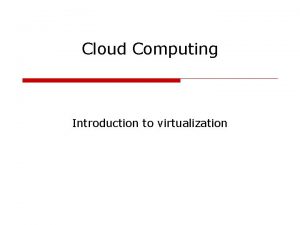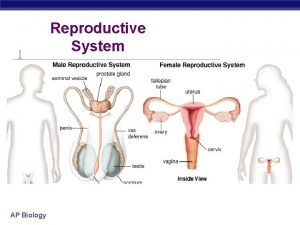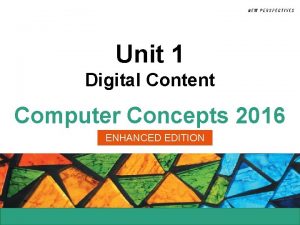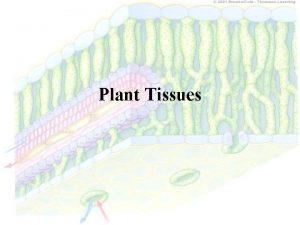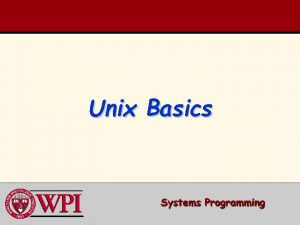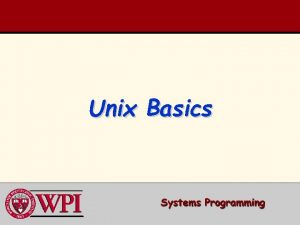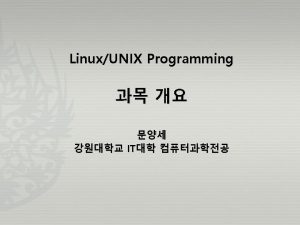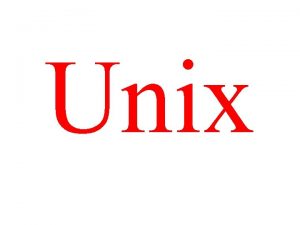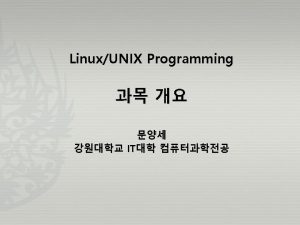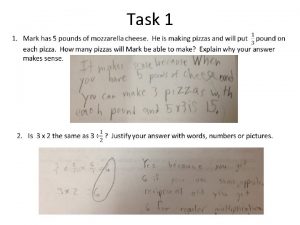Motivation On UNIX each computing task is represented











![exec() – (cont. ) int runcmd(char *cmd) { char* argv[MAX_ARGS]; pid_t child_pid; int child_status; exec() – (cont. ) int runcmd(char *cmd) { char* argv[MAX_ARGS]; pid_t child_pid; int child_status;](https://slidetodoc.com/presentation_image/03aeff94e771e05475bc823781a8f010/image-12.jpg)




![Example – “Parent” and “Child” int main(void) { int fd[2], nbytes; pid_t childpid; char Example – “Parent” and “Child” int main(void) { int fd[2], nbytes; pid_t childpid; char](https://slidetodoc.com/presentation_image/03aeff94e771e05475bc823781a8f010/image-17.jpg)
- Slides: 17

Motivation � On UNIX, each computing task is represented by a process. � UNIX runs many tasks seemingly at the same time � One can run multiple commands and carry out multiple tasks at a time � Each process receives a little slice of CPU time by the scheduler 2

What is a process ? � A process is something of a container, bundling: � a running application � its environment variables � the state of the application's input and output � the state of the process (priority, etc’) 3

The chicken and the egg � Most processes come and go rapidly, as tasks start and complete � So, where does the first process come from? � On UNIX, some processes run from system boot to shutdown � The kernel spawns the first process during the boot sequence � The first process is init and its PID is 1. 4

How many processes do we have? � UNIX system has a finite, yet large pool of processes � In practice, a system almost never runs out of processes � Each new task -- say, launching vi -- immediately allocates a process from the pool with a unique PID $ sleep 10 & ps -o pid, command, state, stime PID 16351 16845 16846 COMMAND S STIME -bash sleep 10 ps -o pid, u S S R 11: 23 11: 42 11: 44 5

Forking a new process � Each new UNIX process is the spawn of an existing process � In UNIX, the fork() system call is used to spawn a new process � A “child” process is a clone of the “parent” process (PID is different), until the “child” continues execution independently � Had you ever “fork” a process ? 6

You are always forking new processes � The ls command in the shell prompt is actually a “child” process � Who is the parent process ? � If a user types the ls command at a shell prompt a new process will be forked � The Linux kernel will duplicate the shell's pages of memory and then execute the ls command 7

fork() � � � The fork() system call returns twice; in both the parent and the child processes In the “parent” process it returns the PID of the “child” process While in the “child” process it returns 0 #include <sys/wait. h> <stdlib. h> <unistd. h> <stdio. h> int main(int argc, char *argv[]) { pid_t cpid; int status; cpid = fork(); if (cpid == -1) { perror("fork"); exit(EXIT_FAILURE); } if (cpid == 0) { /* Code executed by child */ printf("PID is %ldn", (long) getpid()); exit(argc==2? atoi(argv[1]): 0); } else { /* Code executed by parent */ printf("Child PID is %ldn", (long)cpid); wait(&status); /* waits on the exit status from the child*/ printf("%ld exited with status %ldn", (long)cpid, (long)status); exit(0); } } 8

Parent and Child - Example 9

fork() – (cont. ) Process Z has the same environment variables as A, the same memory contents, the same program state, and the same files open 10

Copy-On-Write � “Parent” and “child” processes run simultaneously � They use the same resources until one of them decides to change the data � Then, a unique copy of the considered data is duplicated for its use (copy-on-write) 11

exec() � After the fork, Process A might continue running the same application � However, Process Z might immediately choose to run another application � The later operation is called execution and it is invoked by the exec() system call � It loads a new program, and overrides the parent’s one 12
![exec cont int runcmdchar cmd char argvMAXARGS pidt childpid int childstatus exec() – (cont. ) int runcmd(char *cmd) { char* argv[MAX_ARGS]; pid_t child_pid; int child_status;](https://slidetodoc.com/presentation_image/03aeff94e771e05475bc823781a8f010/image-12.jpg)
exec() – (cont. ) int runcmd(char *cmd) { char* argv[MAX_ARGS]; pid_t child_pid; int child_status; int execvp(const char *file, char *const argv[]); parsecmd(cmd, argv); child_pid = fork(); if(child_pid == 0) { /* This is done by the child process. */ execvp(argv[0], argv); /* If execvp returns, it must have failed. */ printf("Unknown commandn"); exit(0); } else { /* This is run by the parent. Wait for the child to terminate. */ pid_t tpid = wait(&child_status); return child_status; } } 13

Inter Process Communication � Mechanism for processes to communicate and to synchronize their actions � If P and Q wish to communicate, they need to: � establish a communication link between them � exchange messages via send/receive � Implementation of communication link � physical (e. g. , shared memory, hardware bus) � logical (e. g. , logical properties: FIFO) � The logical communication link could be: � Direct - Signals � Indirect - Pipes 14

Signals – Direct Communication � The source process can "raise" a signal and have it delivered to destination process. � The destination process' signal handler is invoked and the process can handle it � A direct communication in which unidirectional channels are established automatically � Processes must name each other explicitly using the process ID in order to send messages of fixed size � Asynchronous What types of signals you are familiar with? 15

PIPES – Indirect communication � A direct communication in which unidirectional channels are established between “related” processes � Basically, a call to the int pipe(int fd[2]) system call attaches a pair of file descriptors to the pipe � One of these descriptors is connected to the write end of the pipe, and the other is connected to the read end � On many systems, pipes will fill up after you write about 10 KB to them without reading anything out write() fd[1] PIPE fd[0] read() 16

Simple example 17
![Example Parent and Child int mainvoid int fd2 nbytes pidt childpid char Example – “Parent” and “Child” int main(void) { int fd[2], nbytes; pid_t childpid; char](https://slidetodoc.com/presentation_image/03aeff94e771e05475bc823781a8f010/image-17.jpg)
Example – “Parent” and “Child” int main(void) { int fd[2], nbytes; pid_t childpid; char string[] = "Hello, world!n"; char readbuffer[80]; pipe(fd); if((childpid = fork()) == -1) { perror("fork"); exit(1); } if(childpid == 0) { /* Child process closes up input side of pipe */ close(fd[0]); write(fd[1], string, (strlen(string)+1)); close(fd[1]); /*close file descriptor before exiting*/ exit(0); } else { /* Parent process closes up output side of pipe */ close(fd[1]); /* what is special about this? */ while (nbytes = read(fd[0], readbuffer, sizeof(readbuffer))) printf("Received string: %s", readbuffer); close(fd[0]); /*close file descriptor before exiting*/ } return(0); } 18
 Write the power represented by each geometric model
Write the power represented by each geometric model Motivation of cloud computing
Motivation of cloud computing Cloud computing motivation
Cloud computing motivation Tiered task bias task
Tiered task bias task Conventional computing and intelligent computing
Conventional computing and intelligent computing Identify each line or segment that intersects each circle
Identify each line or segment that intersects each circle 7-3 more multiplication properties of exponents
7-3 more multiplication properties of exponents The operation represented by parallelograms in flowchart
The operation represented by parallelograms in flowchart Earth is represented nearly perfect by
Earth is represented nearly perfect by Miller-bravais indices hexagonal planes
Miller-bravais indices hexagonal planes The process represented in the diagram best illustrates
The process represented in the diagram best illustrates Me-111
Me-111 Is music speech and other sounds represented in binary
Is music speech and other sounds represented in binary What is the name of the quantity represented as vrms ?
What is the name of the quantity represented as vrms ? Tissue system in plants
Tissue system in plants A mode of fiction represented in a performance.
A mode of fiction represented in a performance. The senate of republican rome particularly represented
The senate of republican rome particularly represented Charles's law
Charles's law

